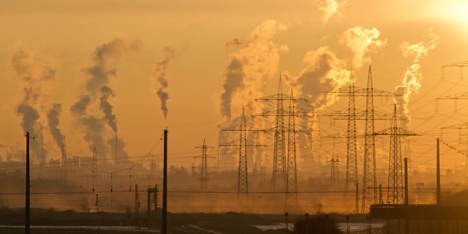
With so most of us staying at home these last few months—socially distanced—pollution levels have plummeted around the world. [See April 23rd blog post.] Many of us celebrated the photos of clean skies and streams, and the resurgence of nature that came with these, though in response many in the media dismissed the gains as only temporary and claimed that pollution will only return when we resume ‘business as usual.’
Granted, pollution will return to stay if we let it, if we continue to ignore it as we did prior to this pandemic. But new studies on the link between air pollution and Coronavirus suggest that it is in our best interests to look at pollution as the health risk that it is.
Although we all want to resume our normal lives of seeing each other, and we will, at the same time we should rethink pollution. More than being just a nice thing for the planet, keeping pollution at bay is a key way to help us stay healthy—and in the process likely slow the spread of Coronavirus.
Ever since the Industrial Revolution, pollution on a grand scale has been on the rise. It’s almost everywhere, pernicious and ubiquitous, that we don’t usually notice it, unless you’re from Beijing, or you are a kid in Los Angeles who has to stay indoors on a high-smog day.
None of us like pollution, of course, but much of the time we can’t see it and, frankly, we probably never expected to see it disappear. (With the exception of those who grew up in Los Angeles during the 70s and 80s and have seen some progress: now they often can see the mountain foothills that used to be always choked with smog.) Politically, the idea of regulating has become so divisive over the years that gains during one presidency are easily lost in another, regardless of which “side” you are on.
Nevertheless, Coronavirus might teach us that it’s time to change. First, it’s teaching us that we are all in the same boat—“sides” don’t matter in a pandemic. Second, it is also reminding us that health matters. Perhaps, this is the perfect time to look at pollution through the lens of health rather than politics. In fact, the new research suggests that we can’t afford not to.
When Coronavirus first hit, I looked to the CDC and World Health Organization statistics to put it in perspective. I was shocked to learn that pollution is a major leading cause of death, each year killing an estimated nine million worldwide. Of these, an estimated 7 million deaths are due to air pollution, and 4 million of these are from outdoor air pollution. As one of the authors of a leading and respected worldwide study puts it, “[a]ir pollution is one of the great killers of our age.” This is exponentially more than the 375,000 worldwide Coronavirus deaths so far this year.,
Most people do not know that air pollution is a major contributor factor in heart disease and strokes. Even in developed nations, particulates from invisible air pollution contributes to heart disease. This should be cause for alarm, since In the U.S. alone, cardiovascular disease is the leading cause of death: in 2016 it killed 840,000 people in the U.S. (635,000 of these were specifically heart-related), a portion of which is avoidable with lower particulate pollution.
What was more shocking to me was realizing that these deaths from pollution are ultimately avoidable—depending on choices about energy sources, etc.—whereas deaths from pandemics are not.
Or are they? We all assume that there is nothing we can do to protect ourselves from viral pandemics except to stay indoors and wear face masks when we go out. But what about all the factors that contribute to make us more susceptible to infection? That is a gargantuan issue that merits its own blog and much more—the overlooked deeper query of why as a society so many of us are immune compromised, or have high-risk health conditions such as cancer and diabetes. Hopefully, one day soon we as a society will examine that question, not just to strengthen ourselves to ward against future pandemics, but also to save all the lives lost to countless other “routine” health epidemics that we have grown accustomed to in our society.
Putting aside that larger question, researchers are beginning to ask important questions about the connection between the narrower issue of air pollution and this pandemic. Interestingly, even if we ignore the issue of how many non-COVID deaths we could avoid by cutting pollution—such as air-related heart disease and strokes—and we focused solely on the impact of air pollution on COVID-19, lowering air pollution would saves lives from Coronavirus. In short, new research shows that higher air pollution means more Coronavirus deaths.
Specifically, the areas with the most air pollution have had the highest outbreaks of Coronavirus and the highest death rates, such as the Lombardy region of Italy, parts of Spain, China, and New York City. Is this due simply to the immediate impact of high pollution on the lungs? Or is it due to more pernicious long-term health effects on the population, which predisposes us to respiratory failure (such as by damage to the lining of the lungs or long-term oxidative stress from air pollutants)?
The answer appears to be yes and yes. The New York Times reported on new studies which show that areas with high air pollution can increase mortality rates from Coronavirus by 15%, and an earlier study on previous SARS outbreaks found that areas with higher air pollution had increased death rates by even up to 84%. And it’s not just areas with extremely high pollution, as in China, that are at risk: the Times article described from the study that New York would have had less deaths from Coronavirus if it had just one point less of 2.5 ppm particulate air pollution.
Scarier, maybe, is the theory that perhaps this virus has “gone viral” in part by being carried and spread by particulate pollution, not just being carried by people. Research still needs to be done on this, but scientists are beginning to ask the question: are pandemic viruses carried by the particulate pollution in the air? Indeed, some wonder whether the reduction in Coronavirus deaths have been in part—or even largely—due to the reduction in air pollution when we stopped ‘business as usual.’ If so, then resumption of high pollution levels as we go back to work could theoretically in itself trigger a relapse of the pandemic.
We don’t know the answers to these questions, but we do know that it’s time for us to take a hard look at health and prioritize changes that will optimize our health and ward against future pandemics. If that means adopting new technology to curb air pollution and annually save millions of lives in the process, then count me in.
1 P. Landrigan et al., The Lancet Commission on pollution and health, Oct. 19, 2017, The Lancet, Vol. 391, No. 10119 (finding pollution causes 9 million deaths worldwide a year, in 2015 6.5 million from air pollution, including over 4 million from outdoor air pollution). See also WHO, Household Air Pollution and Health, May 8, 2018, (stating that “[a]pproximately 11% of all deaths due to ischemic heart disease, accounting for over a million premature deaths annually [worldwide], can be attributed to exposure to household air pollution”).
2 J. Domingo and J. Rovira, Effects of Air Pollutants on the Transmission and Severity of Respiratory Viral Infections, Environmental Research, May 11, 2020 (review article).
3 P. Landrigan, Comment, Air Pollution and Health, November 25, 2016 http://dx.doi.org/10.1016/ S2468-2667(16)30023-8 (stating that “[a]ir pollution was responsible in 2015 for 19% of all cardiovascular deaths worldwide, 24% of ischaemic heart disease deaths, 21% of stroke deaths, and 23% of lung cancer deaths”).
iv,5 For May 2020 updated figures, see: CNN.com, May 31, 2020 (citing worldwide deaths of 376,000); CDC Cases in the U.S., May 31, 2020, CDC.gov (U.S. deaths at 103,700).
6 Id.
7 S. Rajagopalan, S. Al-Kindi, an R. Brook, Air Pollution and Cardiovascular Disease, JACC State-of-the-Art Review, J. of the Am. College of Cardiology, Vol. 72, Issue 17, Oct. 2018, DOI: 10.1016/j.jacc.2018.07.099.
8 EJ Benjamin and A. Alonsa, et al., Heart Disease and Stroke Statistics-2019 Update: A Report from the American Heart Association, Jan. 31, 2019, published by the American College of Cardiology.
9 E. Conticini, B. Frediani, D. Caro, Can Atmospheric Pollution Be Considered a Co-Factor in Extremely High Level of SARS-CoV-2 lethality in Northern Italy?, Environmental Pollution, March 24, 2020.
11 L. Friedman, New Research Links Air Pollution to Higher Coronavirus Death Rates, April 7, 2020, New York Times (reporting that “[a] nationwide study has found that counties with even slightly higher levels of long-term air pollution are seeing larger numbers of Covid-19 deaths”)(noting a 15% increased death rate in areas in the U.S. with higher levels of fine particulate air pollution), found at: https://www.nytimes.com/2020/04/07/climate/air-pollution-coronavirus-covid.html?smid=em-share
Y. Cui, Zuo-Feng Zhang et al., Air pollution and case fatality of SARS in the People’s Republic of China: an ecologic study, Environmental Health: A Global Access Science Source 2003, 2:15 (finding that “SARS patients from regions with moderate APIs [air particulates] had an 84% increased risk of dying from SARS compared to those from regions with low APIs [air particulates]… Similarly, SARS patients from regions with high APIs were twice as likely to die from SARS compared to those from regions with low APIs.”). See also (discussing SARS prior study): J. Domingo and J. Rovira, at n. ii; Friedman at n. x.
12 Friedman at n. x.
14 J. Domingo and J. Rovira at n. i.
See also Friedman at n. x.
15 J. Domingo and J. Rovira at n. i.
Our hearts go out to all affected by the Coronavirus. The April 15th date cited in our April video corresponds to when there were only 30,800 US Coronavirus deaths; on April 18th, worldwide deaths were 160,000. On April 25th the death count from Coronavirus was 50,000 in the U.S. and 200,000 worldwide. Two months later, on May 31st, there are over 376,000 worldwide deaths and 103,700 U.S. deaths from Coronavirus
